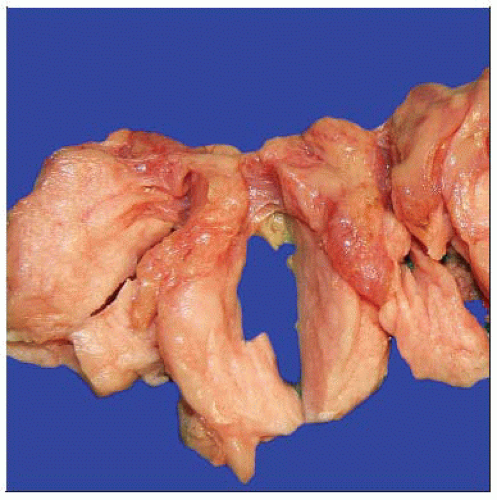Cystic Fibrosis, Pancreas
Mari Mino-Kenudson, MD
Key Facts
Etiology/Pathogenesis
Cystic fibrosis transmembrane conductance regulator (CFTR) gene on chromosome 7q31.2
Clinical Issues
Exocrine pancreatic insufficiency occurs in majority of patients
Macroscopic Features
Granular pancreatic parenchyma secondary to extensive fibrosis, often with cystic spaces
Complete replacement of pancreas by fat, usually with well-preserved architecture
Microscopic Pathology
Multiple ducts totally plugged with concrete mucous resulting in atrophy of exocrine gland, progressive fibrosis, and cyst formation
 This pancreas from a 32-year-old CF patient demonstrates complete replacement of the parenchyma by fat. Note the overall architecture of the pancreas is well-maintained. |
TERMINOLOGY
Abbreviations
Cystic fibrosis (CF)
Synonyms
Mucoviscidosis
Definitions
Autosomal recessive disease affecting fluid secretion in exocrine glands and epithelial lining of respiratory, gastrointestinal, and reproductive tracts
ETIOLOGY/PATHOGENESIS
Cystic Fibrosis Gene
Cystic fibrosis transmembrane conductance regulator (CFTR) gene on chromosome 7q31.2
Encodes an epithelial chloride channel protein and regulates multiple additional ion channels and cellular processes
More than 800 disease-causing mutations have been identified and can be grouped into 6 classes
Most common mutation is ΔF508
Deletion of 3 nucleotides coding for phenylalanine at amino acid position 508
Results in complete lack of CFTR protein at apical surface of epithelial cells due to abnormal protein folding, processing, and trafficking
Stay updated, free articles. Join our Telegram channel

Full access? Get Clinical Tree




